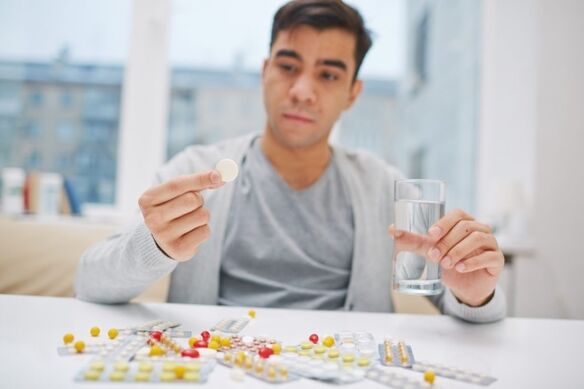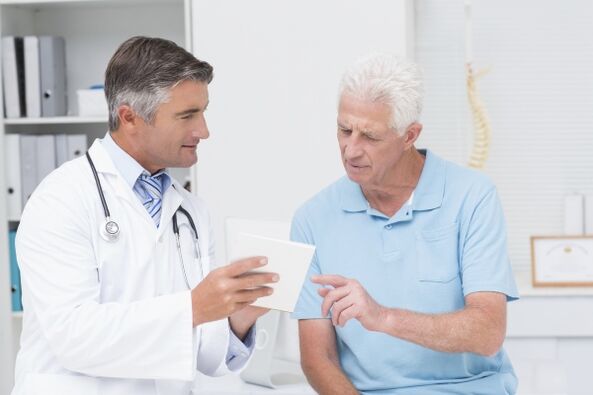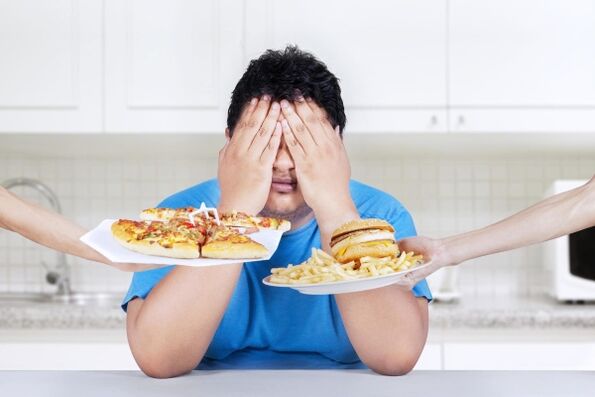If you do not want to prevent chronic prostatitis, carefully examine the causes of the disease, pay attention to the signs of a chronic course and be sure to read the rules of diagnosis and treatment.Read all about it in our article.
Chronic prostatitis is characterized by long-lasting inflammatory processes in the prostate, which lead to morphological and functional disorders of the prostate.It is difficult to get rid of the pathology, the complications are serious, so it is easier to prevent the disease if you know the causes of its development.
Causes
The main reason for the chronic course is untreated prostatitis, which moves into the next phase.The following reasons and factors can contribute to this:
- Infection of the urogenital tract with mycoplasma, chlamydia, herpes, ureaplasma, Candida, E. coli, cytomegalovirus or Trichomonas.
- Congestion of the pelvic organs, which occurs against the background of a sedentary lifestyle, impaired blood supply, poor nutrition and bad habits.
- Frequent hypothermia (the risk group includes people who engage in surfing, diving, skiing, etc.).
- Prolonged abstinence from sexual intercourse, interrupted acts.
- Obesity caused by high-fat foods.
- Disturbances in the endocrine system.
- Inflammatory processes throughout the body, especially chronic ones.
- Weak immune system.
- Injury to the sexual organ.
- Constant constipation.
- Depression, stress, overwork.
Particular attention should be paid to bad habits – alcohol consumption, drug use, smoking.The harmful substances released by such products lead to vascular spasms and reduce blood circulation.As a result, the nutrition of all organs deteriorates.
Symptoms
With chronic prostatitis, the prostate enlarges, compressing the elements of the genitourinary system and narrowing the urethra.As the disease progresses, the gland completely encloses the urethra and severely compresses the canal.Because of this, there are problems with urine excretion.
How to recognize chronic prostatitis:
- Pain occurs regularly in the pelvis and perineum;
- Difficulty urinating and defecating;
- discharge from the urethra is observed;
- The pain spreads to the thighs, testicles and anus;
- there are problems with urination;
- severe burning and itching in the urethra;
- frequent urges;
- decreased libido and erection;
- rapid ejaculation with pain;
- If an infection occurs, the body temperature rises and the condition worsens;
- after a year, infertility appears;
- the appearance of pain after normal physical activity;
- acute urinary retention and false urges;
- sluggish urine stream.
In the initial stages the symptoms appear slowly, but as they progress they become more severe.The pain syndrome becomes very severe and radiates to neighboring organs and areas.Particular attention should be paid to the process and frequency of urination.Against the background of such changes, a man experiences psycho-emotional problems, which are expressed as follows:
- severe anxiety;
- depression or, conversely, aggressiveness;
- insomnia at night;
- obsessions;
- fear of sexual intercourse and urination;
- hot temper and irritability.

classification
The current requirements for the classification of chronic prostatitis were developed in the 95th year of the last century.On this basis, the disease is divided into:
- Chronic bacterial prostatitis.Occurs against the background of an untreated acute bacterial disease.It manifests itself with typical symptoms, but with increased body temperature, chills and fever.During the examination, an increased number of leukocytes and pathogenic microorganisms in the secretion and urine are detected.
- Chronic prostatitis occurs most frequently.
- Asymptomatic inflammatory prostatitis is characterized by the absence of specific signs.Most often discovered by accident.
According to statistics, the most common form is nonbacterial prostatitis.The bacterial form is much rarer (maximum 10 out of 100 cases).This is because when infected, the symptoms are always pronounced, so the patient usually undergoes examination and treatment in a timely manner.
Possible complications and consequences
In chronic prostatitis, exacerbations and remissions occur alternately, and inflammatory processes quickly destroy the prostate gland.Therefore, the following complications arise, which are considered the most dangerous for human life:
- Adenoma.It is produced in the prostate.Inflammatory processes that occur over a long period of time lead to intensive cell division.At the same time, there is hyperplasia of the glandular epithelium in the ducts, causing the organ to become larger.Against this background, benign hyperplasia develops.
- Cancerous growth in the prostate.Occurs more often after prostate adenoma.At an early stage in the development of an oncological tumor, the detection of cancer is problematic.This is because men with chronic prostatitis experience the same symptoms.For this reason, the patient must undergo appropriate urological tests to detect the prostate-specific antigen in the blood.
- Significant decline in erection and further impotence.This is the most common unpleasant consequence.The disease develops in a certain order.At first the erection weakens slightly, then it no longer occurs regularly and ejaculation occurs very quickly.In addition, sexual desire decreases and the patient experiences pain during ejaculation.Then comes impotence.
- Infertility.It occurs within a year of the chronic course of prostatitis.The fact is that chronic inflammatory processes lead to a reduction in the amount of sperm, slower sperm motility and the destruction of their tails and heads.Infertility can be diagnosed using a spermogram.
- Vesiculitis.Inflammation occurs in the seminal vesicles that contain sperm.
- Swelling of the sphincter in the bladder, against the background of which acute urinary retention occurs, leading to death.
- Prostatic sclerosis.The disease is manifested by the replacement of the prostate with connective tissue.This means that strands of connective tissue form that lead to sexual dysfunction.
Further consequences:
- cyst formation;
- stones in the prostate;
- Hemorrhoids;
- cystitis;
- mental instability that needs to be treated.

If a man is diagnosed with chronic bacterial prostatitis, he must have sexual intercourse only with a condom, as the disease leads to infection of his partner.Bacteria invade the fallopian tubes, genital tract and organs, causing disease and female infertility.
Which doctor is treating you?
A urologist treats a man's urogenital system.However, if you come to the clinic for the first time with a similar problem, you must first see a therapist.
In the course of carrying out diagnostic measures, consultation with other highly specialized doctors is also required - an infectiologist, a psychologist, depending on the cause of the disease.
diagnosis
During the first visit to the andrologist, the doctor first takes a medical history, which includes the following:
- Study of the history of urological, infectious, chronic and other diseases;
- Questioning the patient about lifestyle and bad habits;
- Identification of factors contributing to pathology;
- Questioning the patient about the type, type and duration of symptoms.
The doctor then examines the man visually and tactilely and refers him for further examination.
Laboratory methods
What is being done:
- Collection of secreted fluids from the urethral canal.Pathogenic microflora, mucus and leukocytes are determined.
- PCR – scraping from the urethra.Pathological pathogens are identified.
- Microscopic examination of the prostate secretion.Macrophages, amyloid and Trousseau-Lallement bodies as well as leukocytes are counted.
- Immunological examination to determine the level of non-specific antibodies.
- Collection of blood fluid to determine the PSA value.If high values are found, a prostate biopsy is also prescribed, which excludes or confirms a cancerous tumor.
Instrumental methods
Instrumental diagnostics is as follows:
- Ultrasound examination of the prostate.Usually the transrectal method is performed (the sensor is inserted into the rectum).The stage of the disease and its form are clarified by examining the size and echostructure of the prostate, as well as the density and uniformity of the seminal vesicles.
- Myography of the pelvic floor muscles and urodynamic examination.Neurogenic disorders and bladder outlet obstruction are noted.
- Magnetic resonance and computed tomography.Pathological disorders of the pelvic organs and cancerous tumors are detected.A differential diagnosis is then made.
Differential diagnosis
Establishing a differential diagnosis is necessary because it allows timely detection of diseases such as:
- prostate cancer;
- Dysfunction of the bladder of neurogenic etiology;
- Disorders of the detrusor-sphincter system;
- pseudodyssynegria;
- stricture in the bladder;
- hypertrophy of the bladder neck;
- cystitis;
- adenoma;
- Prostatic sclerosis and so on.

Treatment of chronic prostatitis
Therapy for chronic prostatitis is carried out comprehensively - medications are used, massages, physiotherapeutic procedures and exercises are carried out.Of particular importance is the correction of the patient's own life - complete abandonment of bad habits, proper nutrition, normalization of sexual intercourse.In some cases, the help of a psychotherapist and psychologist is required.One treatment method cannot be used without the other, as each method complements the other.
Indications for hospitalization
Treatment of chronic prostatitis is carried out on an outpatient basis, but some patients need to be hospitalized - if serious complications are detected, an advanced form of the disease is present and a positive result is not achieved during therapy.
Antibiotics
For chronic bacterial prostatitis, antibacterial drugs are used.The choice of medication depends on the type of pathogen.The duration of therapy is 2 to 8 weeks.Antibiotics are aimed at destroying the pathogenic microorganism and reducing the inflammatory process.
Different groups are used:
- Aminopenicillin group.
- Cephalosporin medications.
- Macrolides.
- Fluoroquinolone group.
Alpha blockers
This is a group that blocks adrenergic receptors in the tissues of the pelvic organs, thereby stopping spasms in the bladder, improving urine outflow and making urination easier.In addition, the function of the muscles and the sphincter is normalized.
Nonsteroidal anti-inflammatory drugs
Chronic prostatitis is characterized by inflammatory processes in the prostate, which is why it is imperative to prescribe anti-inflammatory non-steroidal drugs.They are aimed at relieving pain and eliminating inflammation.In addition, nonsteroids normalize the permeability of the walls of the circulatory system and restore blood circulation, against the background of not absorbing the existing inflammatory mediators.
The products are used in the form of gels, tablets and injections.
Hormone therapy
If non-steroidal (non-hormonal) drugs do not show a positive effect or the patient has a hormonal imbalance, hormonal drugs are prescribed.They eliminate inflammation, stimulate erectile function and tissue regeneration.
Restoration of blood circulation
Since prostatitis worsens the process of microcirculation in the genitourinary system, the doctor prescribes appropriate medications.When blood circulation returns to normal, regeneration processes are initiated and local metabolism accelerates.Accordingly, the patient quickly gets rid of unpleasant symptoms.In addition, many products strengthen the walls of blood vessels and reduce blood viscosity.

Other medications
For chronic prostatitis, other groups of drugs are also used:
- Muscle relaxants are aimed at relaxing muscles, relieving pain, accelerating blood circulation and reducing the tone of the smooth muscles of the genital organ.
- Immunomodulators correct immune changes, but are primarily prescribed when the patient suffers from immune deficiency.
- If stones are found in the prostate, the patient should take medication that regulates uric acid.
- To destroy the adhesions formed and accelerate the process of action of non-steroidal anti-inflammatory drugs and antibiotics, enzyme drugs are prescribed.
- Vitamin and mineral therapy is indicated to strengthen the immune system.The drug is selected based on the deficiency of a specific vitamin or mineral.
- To restore metabolism in the prostate and regenerate damaged tissue, bioregulatory peptides obtained from the prostate of cattle are used.
- If the disease is accompanied by anxiety, depression, aggression and other mental disorders, sedatives or selective antidepressants are prescribed: tincture of valerian, feverfew.
operation
For chronic prostatitis, surgical intervention is rarely resorted to, and only in cases where the operation is justified and does not pose a risk of complications.In addition, there is a relatively long rehabilitation period after surgical interventions.
In what cases is surgery prescribed:
- if there is no positive result after complex conservative treatment;
- prostate abscess;
- tissue suppuration;
- Inability to urinate:
- benign prostatic hyperplasia;
- cancerous tumors;
- other complications.
Prostatectomy
This operation involves removing the prostate and, in some cases, lymph nodes.Radical prostatectomy according to the surgical method can be of the following types:
- Robotic type – several small incisions are made in the lower abdomen, after which the prostate is removed (the actions are controlled by a special robotic device);
- open type – an incision is made in the lower abdomen;
- Laparoscopic – a small incision is made into which a microscopic camera and instruments are inserted.
Special features:
- Any type of surgery is performed under general or local anesthesia (spinal anesthesia).
- The duration of the procedure is 2 to 3 hours.
- The rehabilitation period is one and a half months.
- The patient's stay in the hospital is a maximum of three days.
- The beginning of sexual life is in one and a half to two months.
- In many cases, a urinary catheter is placed for a week.
- Complications are rare but treatable.
Transurethral resection of the prostate
Surgery involves cutting the tissue surrounding the prostate to make it easier to urinate.This involves using a resectoscope that is inserted into the urethra.The operation is indicated in the absence of urination, as well as for the prevention of such complications - hematuria, inflammatory processes in the kidneys and bladder, stones, urinary incontinence.
Special features:
- Duration of the procedure – from an hour to an hour and a half;
- Stay in the clinic – 2 days;
- Wearing a catheter – 5-7 days;
- recovery period – one and a half months;
- The start of sexual activity occurs after 6 weeks.
Abscess drainage
The operation is used for prostate abscesses that occur as a complication.With this disease, a large amount of purulent exudate accumulates in the prostate, which must be removed from the body.During the operation, a puncture needle is inserted into the gland under ultrasound control.The method is similar to a puncture.
Before injections, the urologist palpates the prostate with the index finger by inserting it into the rectal opening.After suctioning out the pus, antiseptic treatment and drainage with rubber tubes are carried out.If the patient has an extensive abscess, the purulent fluid is pumped out via the perineal access, i.e. through the rectum.
Special features:
- The duration of the procedure is one and a half hours;
- the maximum time spent in the drainage cavity is 72 hours;
- Rehabilitation time – one month.
Laser surgery
Laser treatment is an innovative and most widely used technique as the operation is considered low-traumatic, safe and with minimal recovery time.During the operation, a laser instrument is installed in the urethral canal, the beam of which removes excess tissue.In this case there is no cut.
Removal is done in two ways: ablative (excess tissue is burned) and enucleation (tissue is cut off).Based on the type of removal, laser surgery is divided into the following types:
- Photoselective vaporization – the laser vaporizes tissue.
- Holmium laser ablation – the procedure is identical to the previous one, but a holmium laser is used.
- Holmium laser enucleation – Prostate tissue is crushed with a morcellator and then removed.
Special features:
- minimal number of contraindications;
- absence of side effects (bleeding, etc.);
- You can go home immediately after surgery;
- The duration of wearing a urinary catheter is 24 hours;
- Recovery period – maximum 7 days;
- The only negative is that it cannot be used against cancer.
What consequences can occur after any type of surgery:
- bleeding;
- temporary problems with urination;
- Infection;
- urinary incontinence;
- reverse ejaculation (when sperm enters the bladder);
- swelling of tissue;
- weakening of erection;
- inguinal hernia;
- Shortening of the penis (only if part of the urethral canal is removed).
To prevent complications, you must strictly follow all the surgeon's recommendations during the recovery period.You can't treat yourself.

Physiotherapy
Thanks to physiotherapeutic procedures, the level of inflammation is reduced, pain is relieved, tissue swelling is eliminated, and the effectiveness of medications is increased.What is used:
- phonophoresis;
- electrophoresis;
- laser therapy;
- Transrectal microwave hyperthermia.
massage
Massage is one of the mandatory procedures in the treatment of chronic prostatitis.It is advisable to have the massage performed by a specialist, but if this is not possible, it can be done at home (however, the massage movements should be performed by another person, since the patient is in a relaxed state).
Contraindications to massage:
- hyperplastic changes in the prostate;
- the presence of stones in the organ;
- venous stagnation;
- Formation of cysts and other tumors.
Progress of the procedure:
- The man should expose the lower part of his body and take a lying position - on his side, with his knees drawn up to the abdominal area.
- There is another pose – knee-elbow.
- The person performing the massage must wash their hands thoroughly, wear medical gloves and grease the index finger with petroleum jelly or other emollient.
- The masseur inserts a finger into the anus (the man is relaxed).
- Massage the prostate with gentle stroking movements.
- The duration of the procedure is 2-5 minutes.
If a man lives alone and cannot visit a massage therapist, special urological massagers can be used.The treating urologist will help you choose the model that is best for you.
Diet therapy
A patient with prostatitis must follow a special diet to prevent the formation of cholesterol plaques, constipation and increased gas formation.Dishes must be steamed or boiled.Baking is allowed, but without oil.
Authorized products:
- Seafood;
- pumpkin seeds;
- fruits and vegetables that do not cause gas;
- Porridge;
- fermented milk products;
- dried fruits;
- lean meat and fish.
Prohibited products:
- any beans;
- cabbage;
- carbonated drinks;
- Alcohol;
- spicy and salty dishes;
- strong tea and coffee;
- Yeast baked goods.

Folk remedies
Traditional medicine recipes are used exclusively in consultation with the andrologist, as many of them may have contraindications.
Recipes:
- Eat around 30-40 pumpkin seeds daily, preferably on an empty stomach.
- You can drink pear compote, but only without added sugar.
- Take a healing bath three times a week.To do this, make a decoction of herbs in equal parts: chamomile, sage, pine needles, calendula.Brew according to the standard scheme (for a glass of water - 2 tablespoons of the mixture).Pour into the bath, add sea salt in a free proportion and take a sitz bath for 15 minutes.The water temperature is no more than 40 degrees.
- Use parsley - add it to the salad, squeeze out the juice and drink.The seed portion can also be used.
- Make your own rectal suppositories.To do this, combine propolis with butter and cocoa powder in equal proportions.Form a candle shape with your hands, wrap each suppository in plastic wrap and place in the refrigerator.Administer 1 suppository every evening at bedtime for 30 days.
forecast
If we talk about the prognosis, it directly depends on many circumstances - the degree of neglect, the form of the disease, the adequacy of therapy, the behavior of the patient himself. If you notice the development of a chronic form and carry out treatment on time and correctly, the prognosis is quite favorable.
However, you need to know that in very rare cases there is a complete cure of the disease, but it is possible to achieve a stable remission in which no symptoms appear.
Throughout his life, the patient must strictly adhere to preventive measures, undergo regular examinations and take medications.
Prevention measures
Follow simple rules to prevent the development of chronic prostatitis and its exacerbation during remission:
- contact a urologist in a timely manner;
- lead a healthy and active lifestyle (get rid of bad habits, exercise moderately);
- eat right;
- Sex should be regular – at least three times a week;
- monitor the state of the immune system;
- don't get too cold;
- exclude casual sex;
- Train the muscles of the genitourinary system - do special exercises.
If you suffer from chronic prostatitis, do not be alarmed because this is not a death sentence.With the right therapeutic approach and regular visits to the andrologist, you can lead an active sex life without experiencing unpleasant symptoms.













